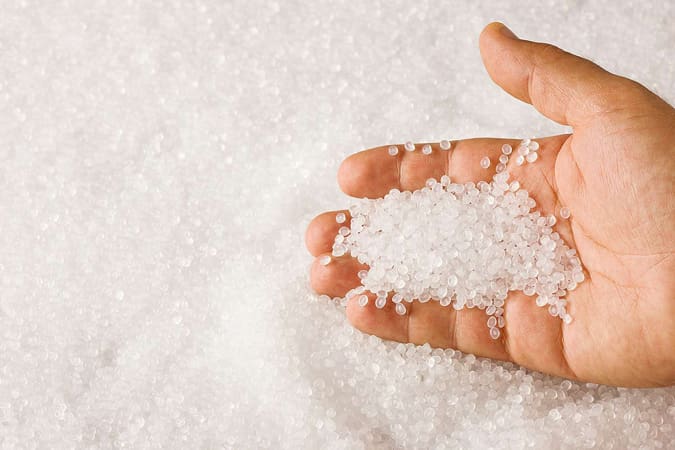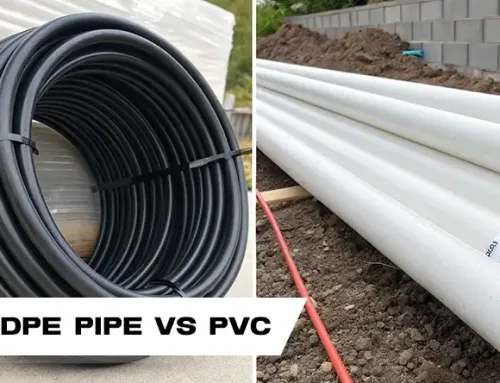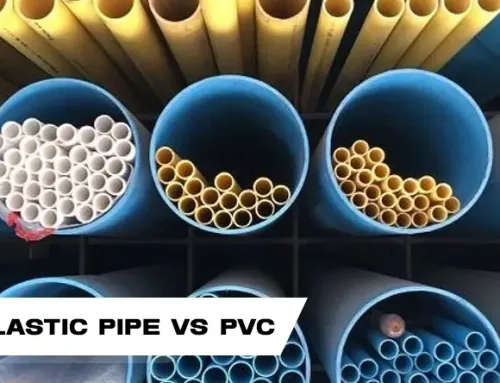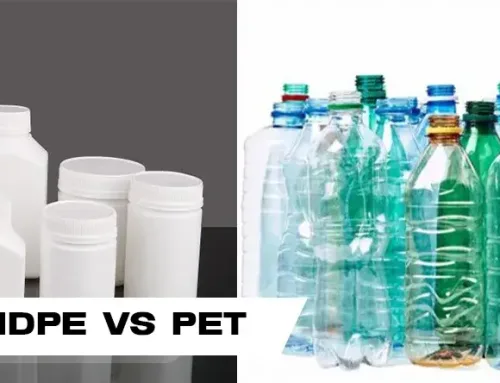Polypropylene (PP) and Polyethylene (PE) are two of the most widely used and versatile thermoplastics in the modern world, making them integral to hundreds of thousands of products and applications across virtually all sectors, from food packaging material to automotive parts. While polypropylene and polyethylene share certain characteristics as polyolefins, their distinct molecular structures and resulting properties mean they are uniquely suited to specific applications. Understanding the fundamental difference between polyethylene and polypropylene is paramount for choosing the optimal plastic for any given application. This guide will provide an in-depth comparison, helping you decide whether polyethylene or polypropylene is the better choice for your needs.
What is Polypropylene (PP)?
Polypropylene is a semi-crystalline thermoplastic polymer derived from the polymerization of propylene monomers. It was first synthesized in the mid-20th century, with its commercial production made possible through the development of catalytic systems such as the Ziegler-Natta catalyst. PP is often classified into two main types: homopolymers, which are more rigid and strong, and copolymers, which offer even better impact strength and flexibility, especially at lower temperatures. The melting point of polypropylene typically ranges from approximately 160°C to 170°C (320°F to 338°F), making it highly suitable for applications requiring heat resistance and sterilization.

Properties of Polypropylene
Polypropylene is widely appreciated for its balanced combination of excellent mechanical, thermal, and chemical properties. When evaluating “polypropylene vs. plastic strength,” PP stands out for its resilience and ability to endure repetitive stress, often performing better than many other general-purpose plastics.
- Flexibility & Fatigue Resistance: While often considered rigid, certain grades of PP offer remarkable flexibility, especially when molded into integral hinges. Its excellent flexural fatigue resistance allows it to withstand repeated bending without breaking.
- High Impact and Wear Resistance: PP offers good resistance to impact, and its surface hardness provides strong resistance to wear and tear.
- Lightweight: It is one of the lightest commercially available plastics, which is a significant advantage in applications where weight reduction is crucial (e.g., automotive parts).
- High Temperature Resistance: With a relatively high melting point, PP can withstand higher continuous operating temperatures than PE, making it suitable for applications that involve heat, such as hot-fill containers or components that undergo sterilization.
- Excellent Chemical Resistance: PP exhibits superior resistance to a wide range of chemicals, including acids, bases, and many organic solvents, making it ideal for containers of corrosive substances.
- Versatile Transparency: PP can be manufactured to be transparent, translucent, or opaque, depending on the specific grade and processing, allowing for aesthetic versatility.
- Good Electrical Insulation: PP has effective electrical insulation properties, making it suitable for electrical components.
- Longevity: It boasts good longevity and performance stability over time in various environments.
Applications of Polypropylene
Polypropylene’s versatility is evident in its broad range of applications across numerous industries:
- Medical Equipment: PP is extensively used for syringes, pill bottles, laboratory ware, and certain surgical instruments due to its good chemical resistance, sterilizability, and inert nature.
- Automotive Parts: For automotive applications, PP is a go-to material for bumpers, dashboards, interior trims, battery cases, and other components, owing to its high strength-to-weight ratio, impact resistance, and heat resistance.
- Food Packaging: Thanks to its excellent moisture barrier properties and chemical inertness, PP is a top choice for rigid food containers (e.g., yogurt cups, margarine tubs), microwave-safe containers, and flexible packaging films. This emphasizes its role in the “polyethylene vs. polypropylene food safe” debate.
- Textiles: PP is widely used for manufacturing fibers, yarns, and fabrics found in carpets, ropes, twine, geotextiles, and even outdoor furniture webbing, leveraging its strength, moisture resistance, and lightweight nature.
- Consumer Goods: From appliance parts and luggage to reusable storage containers and toys.
- Construction: It is used particularly for moisture barriers, adhesive tapes, and industrial liners (such as roof membranes) due to its strength and ability to withstand environmental conditions.
What is Polyethylene (PE)?
Polyethylene (PE) is a semi-crystalline thermoplastic polymer created from the polymerization of ethylene monomers. It is the most widely produced plastic globally. The widespread adoption of PE was significantly advanced by the development of catalysts like Ziegler-Natta, which allowed for controlled polymerization and the creation of polyethylene grades with distinct properties and densities. Thus, by customizing the manufacturing process, PE can be tailored into materials with varying molecular structures and mechanical characteristics, allowing for a vast range of polyethylene products.

Types of Polyethylene: HDPE, LDPE, and LLDPE
The versatility of polyethylene stems from its ability to exist in different density grades, each with unique properties:
-
High-Density Polyethylene (HDPE): Marketed for its high stiffness, excellent tensile strength, and good chemical resistance. HDPE is utilized in rigid applications such as milk jugs, detergent bottles, piping (e.g., water and gas pipes), and cutting boards. When discussing “HDPE vs. polypropylene,” HDPE offers superior rigidity and impact strength at lower temperatures.
-
Low-Density Polyethylene (LDPE): Very versatile and highly flexible, LDPE is characterized by significant branching in its molecular structure. It is commonly used in plastic bags, films, cling wrap, and squeeze bottles due to its pliability and tear resistance.
-
Linear Low-Density Polyethylene (LLDPE): Exhibiting enhanced flexibility, puncture resistance, and tensile strength compared to LDPE, LLDPE is widely preferred for stretch films, durable garbage bags, and robust flexible packaging applications.
The ability of PE to be melted and reformed (thermoplasticity) also makes it highly recyclable, contributing to its suitability for sustainable projects.
Properties of Polyethylene
Polyethylene’s properties vary significantly depending on its density and molecular structure (i.e., HDPE, LDPE, LLDPE), but shared characteristics include:
- Excellent Resistance: PE is highly resistant to water absorption, electricity (making it an excellent insulator), and many chemicals. It also exhibits remarkable impact strength, making it suitable for tough environments and durable products.
- Durability and Toughness: The inherent toughness of PE contributes to its overall durability, enabling its widespread application across many sectors.
- Transparency: While HDPE is opaque, LDPE and LLDPE vary in their degree of clarity, ranging from translucent to clear, which is beneficial for packaging applications where product visibility is desired.
- Safety: PE is generally considered safe for contact with food and is widely employed in food-related applications, as confirmed in the polyethylene vs. polypropylene food safe assessment. It is also non-toxic.
- Low Friction: PE has a low coefficient of friction, which can be advantageous in certain sliding or wear applications.
Nonetheless, PE has a low Limiting Oxygen Index (LOI), meaning it is flammable and burns easily in air. Therefore, it often needs to be reinforced with flame retardants to prevent fire hazards in specific applications.
Applications of Polyethylene
Polyethylene’s adaptability and diverse grades support its extensive use across a multitude of industries:
- Packaging: This is the largest application area. Popular uses include plastic bags, PE film (e.g., stretch wrap, shrink wrap, food packaging films), protective covers, and various types of bottles (milk jugs, detergent bottles).
- Consumer Goods: PE is frequently used for consumer products like bottles, containers, buckets, toys, and household apertures due to its lightweight nature, high strength (especially HDPE), and durability.
- Medical Applications: Because of its inert nature and sterilizability, PE is appropriate for making laboratory bottles, various containers, and protective sleeves/covers for sensitive medical instruments.
- Pipes and Fittings: PE is a preferred choice for water pipes, gas pipes, drainage pipes, and plumbing fittings, where HDPE specifically offers valued features of flexibility, high impact strength, and resistance to corrosion and abrasion. This highlights its significance in the “polyethylene vs. polypropylene pipe” discussion.
- Automotive: Certain grades are used for fuel tanks, wire insulation, and other non-structural components.
- Agricultural: PE film is vital for greenhouse coverings, mulch films, and irrigation tubing.
Polypropylene vs polyethylene: Key Differences

When comparing polypropylene vs. polyethylene, it is essential to focus on their distinct properties, applications, and suitability for various uses. These two immensely popular and versatile polymers, while both polyolefins, possess unique features and disadvantages that make them ideal for different industries. Understanding the difference between polyethylene and polypropylene is critical for informed material selection.
Flexibility: Polypropylene versus Polyethylene
The issue of flexibility is considered one of the key differentiating criteria when choosing between polypropylene versus polyethylene.
- Polypropylene (PP): Generally perceived as more rigid than PE, but certain grades of PP, especially those designed for hinges (known as “living hinges”), exhibit exceptional flexural properties. These PP grades are remarkably flexible without breaking, making PP suitable for integrated hinge applications.
- Polyethylene (PE): PE is broadly more flexible than PP. Among its types, LLDPE is one of the most flexible polyethylene grades available, making it highly versatile and ideal for use in stretch films, flexible packaging applications, and polyethylene tubing. LDPE also offers significant flexibility.
Temperature Resistance: Polyethylene versus Polypropylene
Another key difference between Polypropylene and Polyethylene lies in their temperature resistance ranges.
- Polypropylene (PP): PP has a higher melting temperature (around 160-170°C / 320-338°F) and can withstand higher continuous operating temperatures compared to PE. This makes PP well-suited for applications that involve hot filling, sterilization, or exposure to elevated temperatures.
- Polyethylene (PE): PE generally has a lower melting point than PP (e.g., LDPE at 105-115°C, HDPE at 120-130°C). However, PE excels in colder environments; it can endure freezing temperatures as low as -80°C (-112°F) without becoming brittle. This makes PE (particularly HDPE) the material of choice for cold storage containers, freezer bags, and pipes in cold climates.
Chemical Resistance: PE and PP Plastic
When considering the chemical resilience of PE and PP plastic, PP generally outshines PE in resisting a broader range of chemicals and organic solvents.
- Polypropylene (PP): Exhibits excellent resistance to most acids, bases, alcohols, and many organic solvents. This property makes PP well-suited for applications in medical equipment, chemical packaging, and various automotive components where exposure to harsh chemicals is expected.
- Polyethylene (PE): While also having good chemical resistance, PE is generally less resistant to strong oxidizing agents and certain hydrocarbons compared to PP. Its resistance varies by grade, with HDPE typically offering better chemical resistance than LDPE.
Sturdiness and Weight: Polypropylene and Polyethylene Plastics
- Polyethylene (PE): In terms of overall strength, PE (especially HDPE) is generally tougher than PP, meaning its impact strength and durability are often higher, particularly at lower temperatures. It is more resistant to cracking under stress.
- Polypropylene (PP): PP is comparatively lighter in weight than PE, which plays to its advantage in industries seeking affordable materials for lightweight parts, such as in the automotive or consumer goods sectors. When comparing “polypropylene vs. plastic strength,” PP offers an excellent strength-to-weight ratio and often has higher stiffness than PE.
Transparency and Electrical Properties
- Transparency: When discussing polypropylene vs. polyethylene in terms of transparency, LDPE stands out as the most transparent form of polyethylene, often used for clear plastic bags and films. PP is generally translucent (allowing light to pass through but not clear), though specialty grades can be made highly transparent for applications like clear food containers.
- Electrical Properties: PE provides excellent electrical insulation, making it ideal for wire and cable jacketing. However, PE can be sensitive to triboelectric charge accumulation (static electricity). PP also has good electrical insulation abilities, often with slightly better dielectric strength than PE in certain applications, and is less prone to static buildup.
Weldability and UV Resistance
- Weldability: PE generally has superior weldability compared to PP, making it a preferred choice for applications requiring seamless joining, such as polyethylene vs. polypropylene pipe connections, geomembranes, and large containers.
- UV Resistance: Both polypropylene and polyethylene plastics have inherently poor UV resistance and will degrade when exposed to prolonged sunlight, becoming brittle and discolored. However, the performance of PE in UV environments can be significantly improved with the help of certain UV stabilizers incorporated during manufacturing. PP also suffers from photo-degradation, and while stabilizers can help, it is generally less suitable for direct, long-term outdoor sunlight applications unless heavily compounded with UV inhibitors.
Cost Efficiency
Price is one of the main considerations in many industries. When comparing polypropylene vs. polyethylene on cost, PP is generally more cost-effective per unit weight, providing an affordable option for mass production and high-volume applications. PE grades can vary widely in price, with HDPE often being comparable to PP, while LLDPE can be slightly more.
Summary Table: Polypropylene vs. Polyethylene Key Differences
Pros and Cons of Polypropylene
Polypropylene (PP) offers numerous benefits that contribute to its widespread use, but also comes with certain limitations:
Advantages:
- Lower Cost: Generally one of the most cost-effective plastics
- High Resistance to Moisture and Chemicals: Excellent barrier properties against moisture and broad chemical resistance.
- Excellent Flexural and Fatigue Strength: Ideal for “living hinge” applications and parts subject to repeated bending.
- Effective Electrical Insulation: Good dielectric properties.
- Lightweight: Offers a good strength-to-weight ratio, reducing material usage and transportation costs.
- High Melting Point: Suitable for hot-fill and sterilization processes.
- Sterilizable: Can withstand steam sterilization.
Drawbacks:
- High Thermal Expansion: Can lead to warping or dimensional instability in applications with significant temperature fluctuations.
- Photo-degradability: Inherently poor UV resistance; degrades when exposed to prolonged sunlight unless heavily stabilized.
- Difficulty in Painting and Printing: Due to its low surface energy, PP requires special surface treatments (like flame treatment or primers) for good paint adhesion or printability.
- Flammability and Susceptibility to Oxidation: Can burn and is susceptible to oxidative degradation at high temperatures without stabilizers.
- Poor Low-Temperature Impact: Becomes brittle at very low temperatures (below 0°C).
Pros and Cons of Polyethylene
Polyethylene (PE) also possesses a unique set of advantages and disadvantages that influence its suitability for various applications:
Advantages:
- Exceptional Durability and Impact Strength: Particularly HDPE, offers very high impact resistance, even at low temperatures.
- Resistance to Water and Electrical Conductivity: Excellent moisture barrier and superior electrical insulation properties.
- Malleability and Varying Transparency: Can be easily molded, extruded, and comes in grades ranging from opaque (HDPE) to highly transparent (LDPE).
- High Recyclability: Widely recycled, especially HDPE and LDPE rigid containers (though flexible films are more challenging).
- Excellent Low-Temperature Performance: Retains flexibility and impact strength at very cold temperatures (e.g., -80°C).
- Good Chemical Resistance: Resistant to many common acids, bases, and solvents.
- Cost-Effective: Generally affordable, especially LDPE.
Drawbacks:
- Slow Degradation Rates: Like PP, PE is non-biodegradable and contributes to long-term plastic waste in landfills.
- Dependence on Petroleum Resources: Primarily derived from fossil fuels, though bio-based PE alternatives are emerging.
- Recycling Complexities: While recyclable, recycling complexities arise when PE is mixed with other plastics or for flexible film forms which can contaminate recycling streams.
- Poor High-Temperature Resistance: Lower melting point compared to PP, limiting its use in hot environments.
- Poor UV Resistance: Inherently susceptible to UV degradation (unless stabilized), leading to embrittlement over time.
- Prone to Stress Cracking: Can be susceptible to environmental stress cracking under certain chemical and mechanical stress conditions.
Polypropylene vs plastic strength
When considering the optimal material for an application, “polypropylene vs. plastic strength” is one of the most important factors. As a testament to its stiffness and inherent strength, PP offers excellent strength-to-weight ratios. Its ability to resist breakage, particularly through repeated bending (flexural fatigue), gives it an edge over many other plastics, including certain grades of polyethylene. This makes PP a favored material for products such as automotive bumpers, reusable food containers, and packaging material where rigidity and impact resistance are critical. While HDPE offers superior impact strength in some scenarios, PP often wins on stiffness and flexural fatigue.
Manufacturing and Recycling: Polyethylene and Polypropylene
Both polyethylene and polypropylene plastics are thermoplastics, meaning they can be melted and reformed multiple times, which is a key aspect of their manufacturing and recyclability.
- Manufacturing: Both PP and PE exhibit good processability in common plastic manufacturing methods such as injection molding, blow molding, and extrusion. They are relatively easy to manufacture into complex shapes and films. However, PP is often noted for being easier to 3D print compared to some other plastics, which is beneficial when creating prototypes or parts with unique designs.
- Recycling: Both polymers are technically recyclable. PE typically carries recycling codes #2 (HDPE) and #4 (LDPE), while PP is coded #5. This recyclability contributes to their sustainability efforts. However, successful recycling can become an issue when PP and PE are mixed with other polymers or when they are heavily contaminated, stressing the importance of proper sorting and advanced recycling technologies. Challenges in recycling thin films and bags (often LDPE or LLDPE) are particularly prevalent due to them jamming machinery.
Polyethylene vs polypropylene food safe
Both PE and PP are widely approved for food contact applications and are extensively used in the packaging sector due to their inertness and low toxicity.
- Polypropylene (PP): PP is prone to moisture resistance and can withstand higher temperatures, making it ideal for use in microwave-safe food storage containers, hot-fill packaging, and retortable (sterilizable) films where thermal stability is crucial. It does not leach harmful chemicals into food.
- Polyethylene (PE): PE minimally interacts with food and has excellent moisture barrier properties. It is frequently employed in plastic wraps, plastic carry bags, milk jugs (HDPE), and general food packaging films where flexibility and moisture protection are key.
When comparing polyethylene vs. polypropylene food safety, both materials are reliable and meet stringent regulatory requirements (like FDA standards), but their specific strengths (temperature resistance for PP, flexibility/moisture barrier for PE) make them suitable for different uses.
Polyethylene vs polypropylene pipe
Both PE and PP are used extensively in construction, plumbing works, and various piping systems, but for different specialties.
- Polyethylene (PE): PE (particularly HDPE) is widely used for hydraulic pipes, gas distribution pipes, water mains, and plumbing fittings. PE offers valued features of exceptional flexibility (allowing for coiling and fewer joints), high impact strength, excellent resistance to abrasion, and strong chemical resistance to many corrosive fluids. Its superior weldability makes for seamless, leak-proof connections. This is why “polyethylene tubing vs. polypropylene” often favors PE for large-diameter, buried, or outdoor fluid transfer.
- Polypropylene (PP): As a lightweight pipe component, PP is highly valued for its superior chemical resistance, especially to acids, bases, and hot corrosive liquids. This makes it suitable for industrial process piping, laboratory drainage systems, and in environments containing harsh chemical substances. PP pipes are often used for drainage, waste, and vent (DWV) systems inside buildings.
This balance of features ensures both materials remain essential in discussions of polyethylene vs. polypropylene pipe applications.
Polypropylene vs. Polyethylene Toxicity
oxicity is another important consideration in the polypropylene vs. polyethylene debate, especially for consumer and medical products. Both polymers are generally considered non-toxic, inert, and safe, which is why they are so widely used in medical, food-grade, and toy applications.
When assessing polypropylene vs. polyethylene toxicity, both materials meet stringent regulatory requirements (such as those from the FDA in the US and equivalent bodies globally) for safe contact with food, beverages, and pharmaceuticals. They do not leach harmful chemicals under normal conditions of use. Their inert nature means they do not react with biological systems, making them suitable for use in implantable medical devices in some cases. Therefore, from a toxicity standpoint, there is no significant difference between polyethylene and polypropylene that would make one inherently “better” or “worse” for general safe use.
Polyethylene vs Polypropylene Rope
Polyethylene and polypropylene ropes differ significantly in structure and performance, leading to distinct applications.
- Polyethylene (PE) Ropes: Made from a simpler, more linear molecular chain (HDPE or UHMWPE for very high strength), PE ropes are generally softer, more flexible, and have excellent abrasion resistance. They are often better suited for heavy-duty tasks like fishing nets, mooring lines, or UV-exposed outdoor rigging due to their superior abrasion resistance, durability, and stability in extreme cold (-80°C). UHMWPE ropes offer exceptional strength-to-weight ratios, rivalling steel.
- Polypropylene (PP) Ropes: With branched molecular chains due to methyl groups, PP ropes are typically stiffer, coarser, and uniquely buoyant (they float on water). This makes them ideal for marine sports (e.g., water skiing tow ropes, rescue lines), and chemical-resistant tie-downs where floating is an advantage. However, PP degrades faster under UV light and generally has lower knot security and abrasion resistance compared to PE ropes of similar construction.
Cost and application needs further guide selection. PP is often more budget-friendly for short-term or floating applications (e.g., marker buoys, utility lines) but lacks the long-term outdoor durability of PE. PE, especially high-density variants (HDPE) or ultra-high molecular weight polyethylene (UHMWPE), excels in harsh environments with higher UV resistance, abrasion resistance, and tensile strength, justifying its higher cost for industrial, marine, or prolonged outdoor use. Material science ensures each polymer meets specific safety and performance demands. When considering “polyethylene vs. polypropylene rope,” the choice depends on whether buoyancy and cost (PP) or strength, abrasion, and UV resistance (PE) are more critical.
When to Use PP vs. PE
Understanding the key differences between polypropylene vs. polyethylene helps determine their most appropriate applications. There is no single “which is better plastic or polypropylene” answer; it depends entirely on the specific requirements of the product.
Use PP for:
- Applications requiring high flexural fatigue resistance, such as integral “living hinges” (e.g., bottle caps, toolboxes).
- Items needing higher temperature resistance, such as microwave-safe containers, hot-fill packaging, or parts undergoing sterilization.
- Applications requiring superior chemical resistance to a broad range of solvents and corrosive substances.
- Lightweight components where stiffness and a good strength-to-weight ratio are important (e.g., automotive interior parts).
- Transparent rigid containers.
Choose PE for:
- Applications requiring high impact strength and toughness, especially at low temperatures (e.g., outdoor playground equipment, large tanks).
- Items needing exceptional flexibility and stretchability (e.g., plastic bags, film, squeeze bottles, polyethylene tubing).
- Outdoor use where good UV resistance is crucial (with stabilizers incorporated).
- Piping and fluid transfer systems requiring superior weldability and resistance to abrasion.
- Applications where excellent electrical insulation is needed.
- Items benefiting from a lower friction coefficient.
Conclusion: Polyethylene or Polypropylene Plastic – Making the Right Choice
In the ongoing comparison of Polypropylene vs. Polyethylene, it’s abundantly clear that both materials are indispensable polymers, each possessing distinct advantages tailored for specific demands. While they share commonalities as polyolefins, their differences in molecular structure (branching in PE, methyl groups in PP) fundamentally dictate their properties.
The choice between polyethylene or polypropylene plastic for any given application hinges entirely on a careful evaluation of specific project requirements. Factors such as desired flexibility, required temperature resistance, exposure to chemicals, impact strength needs, UV exposure, and, critically, cost efficiency, all play a pivotal role. There is no universally “better” plastic; rather, it is about selecting the optimal material that provides the best balance of properties and performance for the intended use. By understanding the core difference between polyethylene and polypropylene, industries and consumers can make informed decisions, harnessing the unique strengths of polypropylene and polyethylene plastics to create innovative and effective products that shape our modern world.







Leave A Comment